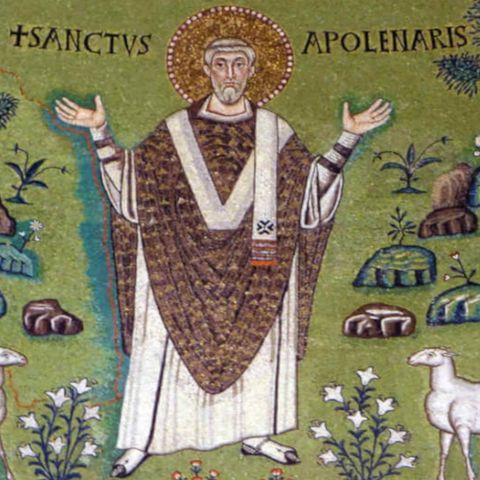July 20: Saint Apollinaris, Bishop and Martyr

Sign up for free
Listen to this episode and many more. Enjoy the best podcasts on Spreaker!
Download and listen anywhere
Download your favorite episodes and enjoy them, wherever you are! Sign up or log in now to access offline listening.
Description
July 20: Saint Apollinaris, Bishop and Martyr First or Second Century Optional Memorial; Liturgical Color: Red Patron Saint of Ravenna, Italy, and invoked against gout and epilepsy An elusive early...
show moreFirst or Second Century
Optional Memorial; Liturgical Color: Red
Patron Saint of Ravenna, Italy, and invoked against gout and epilepsy
An elusive early bishop’s memory is preserved in art
Ravenna, a city on Italy’s eastern Adriatic Coast, is a miniature Istanbul. It has perhaps the most impressive groupings of Byzantine churches and mosaics outside of the former Constantinople. In the centuries after the Western Roman Empire declined, Italy was ruled by various Northern tribes. The Roman Empire was thus reduced to its eastern half in today’s Greece, Turkey, and Syria. Its capital was Constantinople, and its westernmost outpost, and only secure toehold on the Italian peninsula, was Ravenna.
Ravenna’s art and architecture, then, reflect Eastern styles rather than Western ones. And it was in Ravenna where today’s saint, Apollinaris, was bishop for twenty-six years, and where two basilicas with impressive artistic and historical pedigrees still bear Apollinaris’ name. These two permanent proofs of his significance date from the sixth century and, together with an almost equally ancient church in Rome dedicated to his honor, testify to Apollinaris’ legacy in the early Church.
The life of Apollinaris is the subject of conjecture more than analysis. Very little is known about him. Some traditions hold that he was a disciple of Saint Peter and came from Antioch, where Saint Peter was the first bishop. Other traditions, based on some historical evidence about the sequence of bishops in Ravenna, assert that he was bishop there in the late second century. Some legends speak of him as a martyr, while others say he suffered for the faith in the manner of a confessor but was not a blood martyr. Owing to these conflicting histories, and to his apparent lack of universal significance, Saint Apollinaris was removed from the sanctoral calendar in 1969 as part of the liturgical reforms after the Second Vatican Council. There was never any question, however, of removing him from the Church’s official roster of saints. After a long absence, the 2002 edition of the Roman Missal restored the Optional Memorial of Saint Apollinaris.
In the older of the two churches of Saint Apollinaris in Ravenna, an ancient mosaic communicates the essentials. The mosaic is not peripherally located. It is front and center in the main apse, in the direct field of vision of any and all who walk through the doors of the church. It shows a man with white hair. He is old. His skull is shaved. It is the tonsure, showing his religious dedication. A large golden halo circles his head. He is a saint. He is wearing liturgical vestments—a chasuble and stole. He is a priest or bishop. His arms are wide open in what is called the orans, or praying, position so common to early Christian frescoes and mosaics. He is saying Mass. He is wearing a pallium, a small band of white lamb’s wool worn by Metropolitan Archbishops. He is the Archbishop of Ravenna.
Twelve lambs, representing the faithful, look to the figure from both sides. He is an important pastor, a shepherd. His main garment is a white alb. In keeping with the mosaic’s age, and with Ravenna’s status as an imperial city, the alb looks more like a flowing Roman toga. The empire is alive and well. The figure is an equal to all the powerful of the city. Above the figure, tiny, dark stones spell out: +SANTUS APOLENARIS.
Most of the church’s mosaics were wantonly destroyed, likely by the soldiers of a neighboring city, in the fifteenth century. But not this mosaic. It was famous then and is famous now. It is the most tangible evidence imaginable of the importance of today’s saint, an early bishop who suffered for a revolutionary new faith that knew about conquering death.
Saint Apollinaris, we know little about you except what is most important. You were ordained to participate in the fullness of the priesthood of Christ. You gave witness to the faith that your people remembered and memorialized. May we lead lives that are equally deserving of honor and commemoration.
Information
| Author | Fr. Michael Black |
| Organization | Michael Black |
| Website | - |
| Tags |
Copyright 2024 - Spreaker Inc. an iHeartMedia Company
